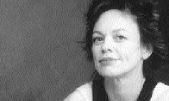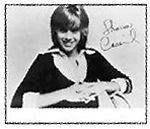HAPPINESS
Moore Theatre, 1932 Second 292-ARTS, $26-$46 8 p.m. Fri., Feb. 15 and Sat., Feb. 16
LAURIE ANDERSON awoke to find an alien landscape outside her window. “There’s a big ice storm here. There’s no power, and iced-over trees are just collapsing,” she reports from Ann Arbor, Mich. “It’s wild.
“I’d forgotten how incredible storms can be here,” adds America’s best-known performance artist, who was born in Chicago in 1947 and grew up with Midwestern winters before moving to the Big Apple after high school. “We don’t have weather in New York anymore. It’s always 60 degrees.”
Fortunately, Anderson has learned to expect the unexpected of late. In preparation for her latest piece, Happiness, she deliberately placed herself in “weird situations” outside her usual routine. Some of them—like spending time on an Amish farm or going on a Zen canoeing retreat—presented themselves organically. “They were just opportunities where normally I would say, ‘I’m too busy to do that.’ And then I thought, ‘You know what? I’m not too busy. I’ll just give it a try.'”
Looking for an atypical adventure closer to home, she took a job at McDonald’s. “It was great fun,” she confesses, sounding dazed by this revelation. “None of the other people that worked there were really doing that as their primary job, as is typically the profile of a McDonald’s worker. A lot of our [staff] were retired people, who basically said the extra money is nice, but I’m doing this because I want to be with people.”
“It was a wonderful atmosphere,” she reiterates. Especially when contrasted with her current gig as a consultant for the upcoming Swiss Expo. “That work team is not one of those happy groups. There’s all of this pressure, and everything that comes up is a problem. When I compare that to McDonald’s, I think, ‘Boy, we actually made a lot of things and had a pretty good time.'”
The other surprise that shaped the content of Happiness was less pleasant. Although she was out of town on Sept. 11, her voice darkens audibly when she speaks of its impact; the downtown loft where she has lived and worked for years is just 10 blocks from Ground Zero. “I don’t know when I’m ever going to absorb what that meant,” she confesses. “This thing that I was working on was going one way, and when this happened, I kind of took a U-turn.”
“I know what disturbed me the most about [Sept. 11], though,” she adds. “I was on tour in Europe in October, and it was frightening. What they know about our reactions is basically through Moneyline, so we come across as people that are worried about our investments. All these old clich鳠were in play. They preferred to look at us as a bunch of salespeople who don’t know what we’re doing and have no thought except for the money we’re going to make—and it’s really insulting.”
“Then again, we have a president who goes, ‘The solution? Shopping!'” she concludes a minute later. “Maybe the Europeans are right.”
Anderson has an amazing speaking voice (and no, in conversation she doesn’t pause . . . like . . . that), cheerful yet quietly confident, like your dream mom. You can imagine her nervous, maybe, but certainly never frightened. Yet Anderson admits she felt vulnerable dealing with the self-portrait aspect of Happiness, which eschews the observational humor that fueled previous works like United States in favor of revealing anecdotes about her own life, such as when she recounts being hospitalized after breaking her back as a child.
“It’s a story I’ve told my friends once in a while, but it had a certain slant. The point was sort of the funny things, about the people who would come and read to me and these doctors who told me that I’d never walk again.” Then one day, she realized she’d been recounting it “all wrong. I’d forgotten what the story was really about, which was that I was incredibly afraid.”
Don’t show up looking forward to hearing songs from Anderson’s sublime 2001 album Life on a String (on Nonesuch), either. “The music—if you can even call it that—is very, very played down,” she says; she uses just a bare minimum of keyboards, violin, and digital processing so as not to distract from the stories.
Lastly, if you’re a fan of her big multimedia productions, like 1999’s Songs and Stories From Moby Dick, be prepared to be shocked by the minimal staging and structure. “I’m just basically kind of DJing some things while telling the stories, so I can skip around, depending on what I think at the moment.” Which means you’ll never know what kind of Happiness you’ll wind up with next. And that, as Laurie Anderson discovered along the way, is a good thing.






